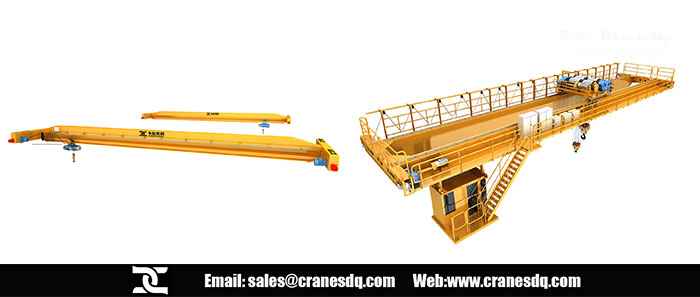Modular cranes and process crane, which is right for your application? After amount of engineering and fabrication, Dongqi crane will offer you the most suitable overhead crane, gantry crane, and jib crane or other workshop cranes either it is process crane or modular crane.
Is an overhead crane needed for to the workshop in your facility? What is the right overhead crane for your application, the modular crane or the process crane (also called the engineered crane)?
The main difference between a modular crane system and a process crane is the amount of engineering required to design and build the bridge crane system. Special consideration has to be given to:

single girder overhead crane v.s Double girder overhead crane - Dongqi Types of cranes for sale
An overhead modular crane is a pre-engineered overhead crane system, including all the bridge crane components and parts, but without the excluding the bridge girder(s) and the paint system.
These pre-engineered process cranes do not need particular designs for a specific process but for the general purpose material handling. The modular cranes has the following typical features, such as
Low crane duty, low load handing capacity within 10 ton, with more standards span and runway ranges, low travelling speeds and operated in a low frequency.
What’s more, the crane components and parts of the modular cranes are off-the-shelf parts, which includes crane electrification, crane controls, electric hoist, crane motors, and drives, etc.
The off-the-shelf crane components and cranes parts can go match with the pre- specified ranges of crane capacity, crane span, and application, etc.
The modular cranes can be top running crane design or under running crane design. The crane bridge girders can be configured in a single girder crane design or double girder crane design and are manufactured to order according to the required span and capacity of the crane system.
Modular cranes are widely used in general industrial, and light manufacturing industries, maintenance and machine workshops, etc.
A modular crane systems are recommended when the following factors are fulfilled:
“ Modular + engineering” crane system is between the modular crane system and a fully engineered process crane.
The modular + engineering crane system is composed of off-the-shelf components, and engineering components designed based on the customer’s requirements and applications requirements.
Modular crane system is the most economical solution for many business owners. Once the modular crane system is fully fits your usage, application, budget and delivery requirements, then it would be a good crane system for you.
How to get your modular crane system a good return on your investment?
During overhead crane designing, special consideration is required for the future usage requirements, such as, the higher capacity lifts or an increase in the number of lifts per day in the future. )
Over-specify a crane system, the initial cost for the crane and runway system may be higher, but the maintenance cost will lowered in a long terms. , If your crane system is being over-used, or was under specified to begin with, the cost of the maintenance, service, and repair may cost more.
Since the off-the-shelf components are used in the modular crane system, the working life of the included parts will influence the performances of crane system. Then the sustainable supply of the crane components need to be guaranteed or it may cost longer breakdown time or cost much to purchase it which may not be worthy, comparing with buying a new crane system.
Attention: On the crane system buying, it should take the total cost of crane system in 3-5 years or even 10 years in the long run. If you have any doubt or question, please feel free to contact us. Or leave a message below.

Process crane for steel industry
Process cranes are designed and fabricated, based on the specific requirements and applications. The process crane is highly engineered crane system, which is designed to withstand the rigors and high crane duty service in a critical lifting action over and over again.
For certain applications, the process cranes is required for heavy duty material handling, which usually are the following industries and workshops:
An engineered crane system is focused on the design which is individualized by a specific process or unique lifting application. One processed engineered crane system may highly differentiate with the other even though with the same specs or components as a similar capacity crane used in a steel mill or a paper mill.
On an engineered overhead crane system, each components of the process crane is given high consideration. On this occasion, each specialized and robust component is designed to meet the strict requirements of crane design and production.
For variable speeds and strict load control, the encoders and flux vectors are used on the motors.
Blog